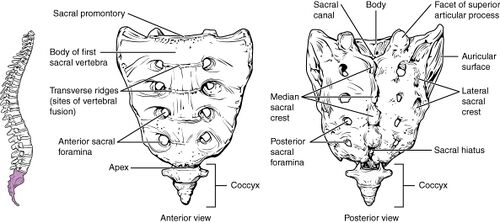Sacrum
The sacrum usually has five fused sacral vertebrae. However variations are common such as lumbarisation of S1, sacralisation of L5, fusion of the coccyx, and spina bifida (see Transitional Vertebral Anatomy). The sacrum is wedge shaped with concave anterior and convex posterior surfaces.[1]
Gross Anatomy
Anterior Aspect
There is a central mass that is formed by the fused vertebral bodies. This is the floor of the sacral canal. The central mass runs laterally until the four anterior sacral foramina.
The ventral rami of S1-S4 pass through the foramina.[1]
Posterior Aspect
The posterior convex arch is formed by the fused vertebral arches. This is the roof of the sacral canal.
There are four posterior sacral foraminae opposite to the anterior foramina where the posterior rami of S1-S4 run. S5 runs between the termination of the sacrum and the coccyx.
There is a median crest that runs down to the sacral hiatus where there are cornuae on each side. The sacrococcygeal ligament covers the sacral hiatus posteriorly.[1]
Lateral Aspects
The lateral mass reduces in size as it goes distally giving the sacrum its triangular shape. It joins with the ilia forming the sacroiliac joints.
The cranial aspect of the lateral masses form wings called alae on either side. These are crossed by the lumbosacral trunk, L4 and L5.[1]
Sacral Canal
The dural sac typically terminates at S2 but can run more distally especially in children. Below the dural sac in the sacral canal there is extradural fat, vertebral venous plexus, lower sacral nerve roots, and the filum terminale.[1]
The mean AP diameter of the sacral hiatus is 4.6 ± 2 mm to 6.1 ± 2.1 mm, and decreases with age.[2]
Tarlov cysts can be found below the S3 level.[2]
Sacral Hiatus
This is a triangular gap on the posterior aspect of the caudal end of the sacrum. The hiatus arises due to failure of fusion of the lamina of the S5 segment. It is called spina bifida occulta when the defect is large.
On the lateral aspects of the hiatus are the margins of the deficient S5 laminae. Inferior to these are the sacral cornuae. The sacral cornuae are found about 5cm above the tip of the coccyx at the upper end of the natal cleft.
The S5 body is found anterior to the sacral hiatus.
The 1-3mm thick sacrococcygeal ligament covers the sacral hiatus. It runs from the cornua to the coccyx. Overlying the ligament is subcutaneous fat and skin.[1]
Articulations
- Sacrococcygeal Joint
- Sacroiliac Joint
- Lumbosacral: L5/S1 intervertebral disc, and L5/S1 zygapophysial joints.
Muscles
- Iliacus: anterosuperiorly
- Piriformis: anteroinferiorly
- Erector spinae: posteriorly
- Gluteus maximus: posteriorly
- Coccygeus
See Also
References
- ↑ 1.0 1.1 1.2 1.3 1.4 1.5 Ellis, Harold (2009-11). "The sacrum and caudal block". Anaesthesia & Intensive Care Medicine (in English). 10 (11): 528–529. doi:10.1016/j.mpaic.2009.08.007. Check date values in:
|date=(help) - ↑ 2.0 2.1 Sekiguchi, Miho; Yabuki, Shoji; Satoh, Koichiro; Kikuchi, Shinichi (2004-01). "An anatomic study of the sacral hiatus: a basis for successful caudal epidural block". The Clinical Journal of Pain. 20 (1): 51–54. doi:10.1097/00002508-200401000-00010. ISSN 0749-8047. PMID 14668657. Check date values in:
|date=(help)


